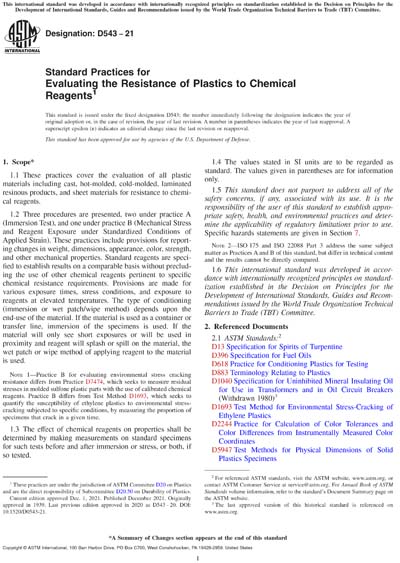Most recent
ASTM D543-21
Standard Practices for Evaluating the Resistance of Plastics to Chemical Reagents
1.1These practices cover the evaluation of all plastic materials including cast, hot-molded, cold-molded, laminated resinous products, and sheet materials for resistance to chemical reagents.
1.2Three procedures are presented, two under practice A (Immersion Test), and one under practice B (Mechanical Stress and Reagent Exposure under Standardized Conditions of Applied Strain). These practices include provisions for reporting changes in weight, dimensions, appearance, color, strength, and other mechanical properties. Standard reagents are specified to establish results on a comparable basis without precluding the use of other chemical reagents pertinent to specific chemical resistance requirements. Provisions are made for various exposure times, stress conditions, and exposure to reagents at elevated temperatures. The type of conditioning (immersion or wet patch/wipe method) depends upon the end-use of the material. If the material is used as a container or transfer line, immersion of the specimens is used. If the material will only see short exposures or will be used in proximity and reagent will splash or spill on the material, the wet patch or wipe method of applying reagent to the material is used.
Note 1:Practice B for evaluating environmental stress cracking resistance differs from Practice D7474, which seeks to measure residual stresses in molded sulfone plastic parts with the use of calibrated chemical reagents. Practice B differs from Test Method D1693, which seeks to quantify the susceptibility of ethylene plastics to environmental stress-cracking subjected to specific conditions, by measuring the proportion of specimens that crack in a given time.
1.3The effect of chemical reagents on properties shall be determined by making measurements on standard specimens for such tests before and after immersion or stress, or both, if so tested.
1.4The values stated in SI units are to be regarded as standard. The values given in parentheses are for information only.
1.5This standard does not purport to address all of the safety concerns, if any, associated with its use. It is the responsibility of the user of this standard to establish appropriate safety, health, and environmental practices and determine the applicability of regulatory limitations prior to use. Specific hazards statements are given in Section 7.
Note 2:ISO 175 and ISO 22088 Part 3 address the same subject matter as Practices A and B of this standard, but differ in technical content and the results cannot be directly compared.
1.6This international standard was developed in accordance with internationally recognized principles on standardization established in the Decision on Principles for the Development of International Standards, Guides and Recommendations issued by the World Trade Organization Technical Barriers to Trade (TBT) Committee.
Content Provider
ASTM International [astm]






